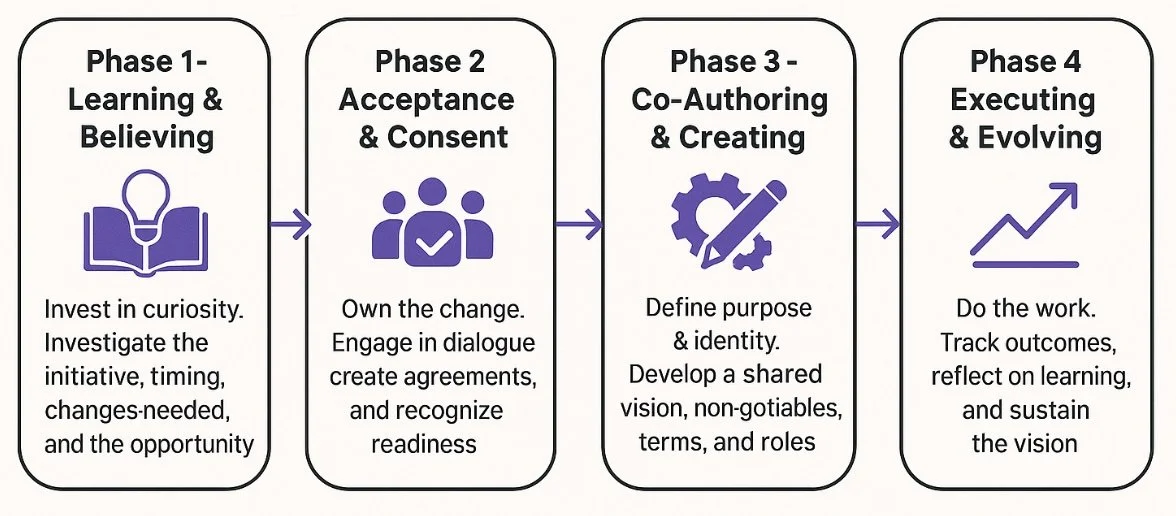What does it mean to live change? Hint: The answer isn’t in a playbook
Like many of you, my leadership training reinforced the idea that change could be planned, managed, and measured—that if I built a thoughtful plan, people would move through each stage in sequence and success was more likely. Buy-in and momentum would build over time.
But organizations today require something different. And while systems are shifting, people are too. Employees are navigating the same uncertainty—grappling with exhaustion, rising costs of living, job insecurity, and questions of purpose and belonging. The ground keeps shifting beneath individuals and institutions, making the old playbooks feel obsolete.
“Wait! They are my manager?”
Managing isn’t just for managers. Matter of fact, at some point in your career, you have come across managers who manage, managers who lead, some who balance both, and likely some who do neither. While you’ve been honing your skills, preparing for the next steps on your career journey, and growing your capacity, you keep running into people who seem to have skipped the honing, preparing, and growing and seemingly out of nowhere, just became a manager. And now, they’re your manager.
So, what do you do? Stay out of the way? Focus on your own work? Vent to colleagues? Manage up?
Exiting the C-Suite? Do It With Care, Integrity & Impact
Recently, Dr. Brandy Nelson, one of our writers at The Nelson Pages had a chance to spend time on the THRIVE Life Coaching podcast with Dr. Alison Harris Welcher. During the podcast, Brandy spent time talking with Alison about leadership transitions — exploring ideas around knowing when to leave a role, measuring purpose and performance in a role, and exiting with integrity and intentionality. You can find the full episode here.
In this issue, The Nelson Pages is digging deeper, specifically, the phenomenon of leadership transitions at the chief executive level–the c-suite.
Why is it so challenging to leave a role? How do you exit out of your role the way you want to, ensuring you maintain integrity, care, and sustainable impact?
Job Malaise? Is Role Clarity to Blame?
If we reframe the question, “Is this job doable?” to “What is my role in this organization?”, immediately, we begin to consider an age-old challenge in the workplace: Role Clarity. Most of us know that role clarity is a significant driver of employee retention, satisfaction, and productivity. However, most of us are probably thinking about how to design, implement, and sustain role clarity in the wrong ways. In our efforts to provide better role clarity for our direct reports, perhaps we are solving for the wrong things.
The In-Service Illusion: Why Participation Isn’t Progress or Impact
In-service. In-service training, in-service learning, in-service programs. As an employee of an organization, we are all familiar with in-service–the professional development we receive to build our skills, knowledge, or performance for a company–while employed with that company. Too often, there is little attention paid to engagement, shared meaning-making, or relevant application. As a result, systems are created that track participation, not learning or growth.
As a manager, you are likely being assigned and assigning training; you may even be leading it or designing it. So, how can you create an experience where adults are part of the learning, not just subject to it.
How do you develop an experience that isn’t about employees in-service to the organization but is about you being in-service to them?
Manager-as-Sower
Do you wear a mask? Not literally, but figuratively. As you lead and support others as a manager or executive, do you have a veneer? If you do, you’re not alone. When I have asked managers across the country why, most say it’s because they do not feel safe being their most authentic self in the workplace.
So, why might we not feel safe in the workplace? How does this feeling show up? And what should we do about it?








